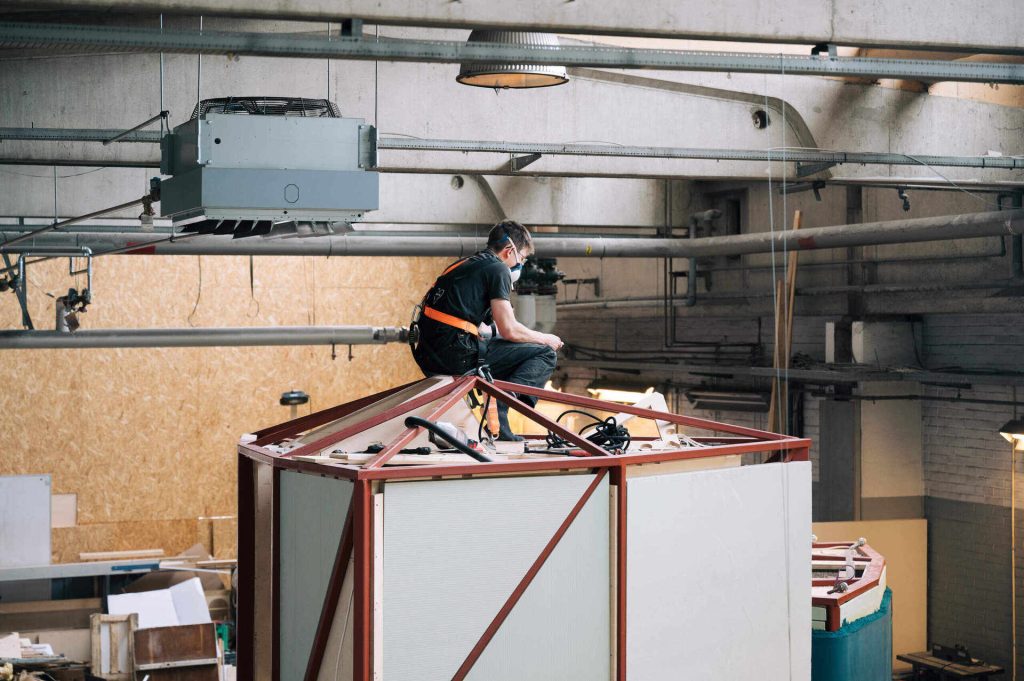SAGA has finished designing and building their 2nd analog moon habitat (Rosie – 3D Printed Habitat), which was designed, constructed, and installed in 9 months!
For 3D printed habitat, Rosie, SAGA partnered with Institut auf dem Rosenberg. Designer of the Rosie, SAGA, is a new design practice working on making space livable for future space travelers by approaching the design of habitats from a human perspective. Like all of their projects, they were inspired by nature.
Design Process
SAGA decided that given Starship’s promise as a future means of transportation in space, this would be an opportunity to design around it as the primary transportation platform. The first constraint SAGA decided to work from is the dimensions of the Starship cargo bay. Given its cylindrical nature, the first designs focused on circular shapes.
SAGA constructed the structure as a hexagon with fit 6 in a single payload if the habitat footprint was triangular. This also makes sense when you realize a triangle’s rough dimensions as a living space.
Topology Optimization
The organic shape of the shell surface is indeed not arbitrary either. It is based on algorithmic optimizations called Topology Optimization, which slowly morphs a shape through many iterations, constantly evaluating the shapes and continuing with derivatives of the best ones.
In SAGA’s case, the shape is being optimized to maximize strength for internal pressure (since the habitat would be pressurized and the outside would be a vacuum) while minimizing the weight and material usage. Finally, SAGA adjusted and cleaned up the shape to make it 3D printable and more aesthetic.
3D Printed Shell
The shell is 3D printed as 6 panels that fit snuggly around the entire structure. The shell is made of a custom ABS polymer which is glass fiber reinforced, and UV stabilized to keep its color in the sunlight.
Sleeping Pods
The habitat has two sleeping cabins on the top floor. They have a comfy and soothing textile covering the walls and ceiling, making it a relaxing cocoon where one can get some privacy. It also has personal storage, and the light is indirect, giving the illusion of natural daylight from above.
Dashboard & Table
The Living Quarters are on the middle floor. Here the crew can access two touch dashboards to control all habitat functions. They can also monitor sensor data. This section also has a table that can be folded to maximize space usage.
Desks
The Living Quarters has two desks, one for each crew member. The work surface is evenly lit, and two big storage cabinets are overhead for personal storage. The desks fold, so the crew can use the space when not using each desk. There is also a window next to each desk so the crew member doesn’t feel too encapsulated.
Ladder
A custom-manufactured ladder is the primary means of traversing the habitat. With cork pads on each step, you have a good grip that is not too harsh on the feet.


Airlock
All capsules that go to space need an airlock to allow a buffered zone for pressurizing/depressurizing. The Rosie has a clean, futuristic airlock with sleek panels that make it easier to wipe down dirt before moving further into the habitat. The airlock also has an automatic hatch that can be opened from the dashboard to allow the Spot robot dog access.
Workshop
The workshop consists of a large worktable with several shelves for storage above. Under the worktable is a charging station for the Spot robot dog. The workshop also has a cabinet for experiments and storage and a dashboard to control the habitat.
Karl-Johan Sørensen, co-founder at SAGA Space Architects, will lecture at Computational Design: NEXT 12 on December 10-11, 2022. Register for the program to learn more about SAGA’s works and more!























Leave a comment